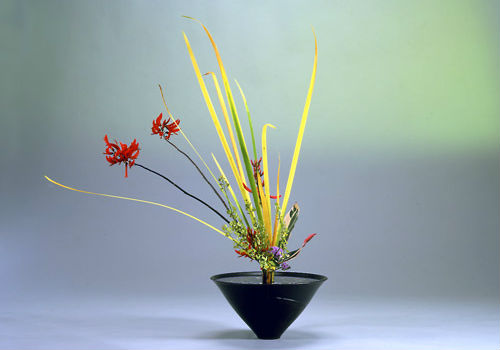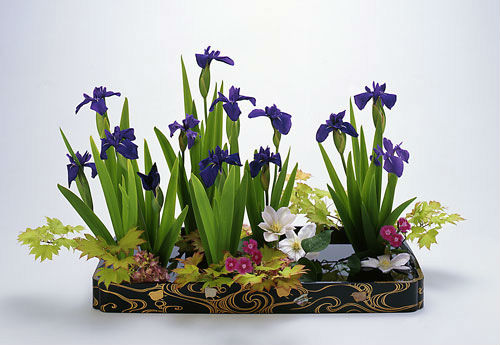Japanese Ikebana arts: Beyond the arrangement of flowers
(VNF) – Ikebana, the Japanese art of flowers arrangement has been the pride of Japan in the last several centuries. However, the key attributes of this art are still not something familiar to most foreigners.
What is Ikebana?
In Japanese language, Ike means ‘alive’ or ‘arrange’ and bana means ‘flower.’
So simply, Ikebana means ‘flowers kept alive'.
Ikebana is the Japanese art of flower arrangement. It is more than simply putting flowers in a container. It is a disciplined art form in which the arrangement is a living thing where nature and humanity are brought together. It is steeped in the philosophy of developing a closeness with nature.

Illustrative photo (source: www.japan-zone.com)
The growing appreciation of Japanese art and architecture in the West has extended to the Japanese way with flowers. Ikebana is an art, in the same sense that painting and sculpture are arts. It has a recorded history; it is backed up by articulate theories; and it is concerned with creativity. In Japan, flower arrangements are used as decorations on a level with paintings and other art objects.
How is ikebana different from flower arrangement?
While flower arrangement for many people in the West consists of symmetrically arranging flowering plants in a vase, Ikebana is an asymmetrical form and the use of empty space as an essential feature of the composition. A sense of harmony among the materials, the container, and the setting is also crucial. Ikebana, or the art of Japanese flower arrangement, shares traditional techniques of Japanese design with Japanese architecture, landscaping, calligraphy, and other traditional arts.
Furthermore, Ikebana aims not at bringing a finite piece of nature into the house, but rather at suggesting the whole of nature, by creating a link between the indoors and the outdoors. This is why arrangers are likely to use several different types of plants in a single arrangement, and to give prominence to leaves and flowerless branches as well as blossoms. Even when a single type of flower is used, an attempt is made to bring out its full implications as a symbol of nature.
Ikebana and the Japanese love of nature
The Japanese have always felt a strong bond of intimacy with their natural surroundings, and even in contemporary concrete-and-asphalt urban complexes, they display a remarkably strong desire to have a bit of nature near them. Foreign visitors to Tokyo are often surprised to notice that their taxi driver has hung a little vase with a flower or two at the edge of the windshield.
That’s how arts involving nature like bonsai and Ikebana are treasured that much in the country.
Nature is always changing. Plants grow and put forth leaves, flowers bloom, and berries are borne regularly and repeatedly throughout the seasons. Nature has its own rhythm and order. The awareness of this is the first step in involving oneself in ikebana.
What are ikebana arrangements made of?
Illustrative photo (source: en.ritsumei.ac.jp)
Its heart is the beauty resulting from color combinations, natural shapes, graceful lines, and the meaning latent in the total form of the arrangement.
Whether a work is composed of only one kind of material or of many different kinds of materials, the selection of each element in the arrangement demands an artistic eye. An arranger with considerable technical skill combines materials to create a kind of beauty that cannot be found in nature.
What are the basic equipment in Ikebana and how to use them?
Similar to other style of floral arrangement, scissors and vases are the key tools in Ikebana:
-Scissors: Japanese use Hasami (clippers or scissors) to cut flowers and stems to their desired lengths. Although the way stems are cut depends on the type of plant and arrangement, most cuts are made at an angle. This makes them easier to secure in the vase and kenzan and makes the area for drawing water larger.
-Vase: There are three types of vase often used in Ikebana, which are: Kabin, Utsuwa and Kenzan
+ Kabin: Tall vase used in making heika arrangements. Crosspieces are used to secure stems at three points.
+ Utsuwa: Low, shallow container for moribana. A kenzan is used to secure the stems and flowers.
+ Kenzan: A holder with many sharp points about 1 centimeter high into which flowers are inserted so that they are fixed firmly.
Do men also do Ikebana?
Today, there are about 3,000 ikebana schools in Japan and thousands more around the world. The Ikenobo school alone has some 60,000 teachers worldwide. Ikebana is practised by about 15 million people in Japan, mostly young women, but actually both men and women study this art form.

Illustrative photo (source: www.japan-zone.com)
Is ikebana difficult?
To say that ikebana is a full-fledged art does not mean that it is esoteric. The greatest creations in the field are apt to be made by the most highly skilled experts, but, as in painting and sculpture, there is plenty of room for amateurs. Almost anyone with a little time and inclination can acquire sufficient skill to make beautiful arrangements. Still, as in the other arts, it is necessary to master certain fundamental techniques before proceeding to free creation.
Spiritual aspects of ikebana
Recommended
 Handbook
Handbook
Vietnam Moves Up 8 Places In World Happiness Index
 Handbook
Handbook
Travelling Vietnam Through French Artist's Children Book
 Multimedia
Multimedia
Vietnamese Turmeric Fish among Best Asian Dishes: TasteAtlas
 Handbook
Handbook
From Lost to Found: German Tourist Thanks Vietnamese Police for Returning His Bag
Popular article
 Handbook
Handbook
Prediction and Resolution for the Disasters of Humanity
 Handbook
Handbook
16 French Films To Be Shown For Free During Tet Holiday In Vietnam
 Handbook
Handbook
Unique Cultural and Religious Activities to Welcome Year of the Snake
 Handbook
Handbook



